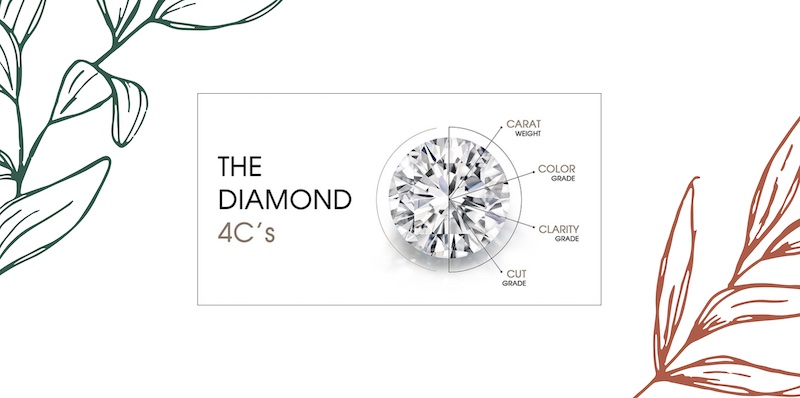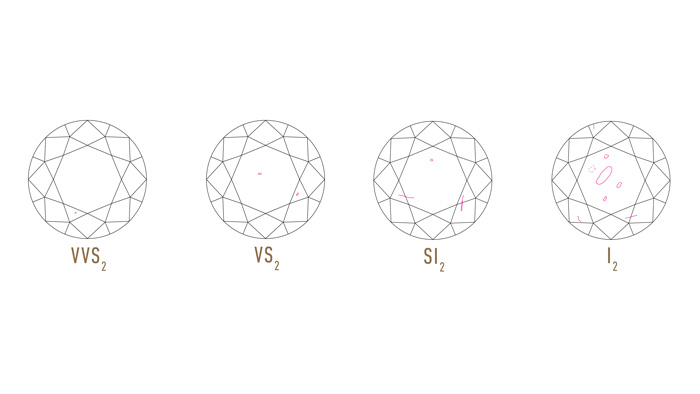©2024 Lab Diamonds Reviews – All Right Reserved.
Education
4cs of Lab Diamonds

This article has mentions of products from one or more companies, and I may receive compensation if you purchase those products following reading my recommendations.
In the radiant realm of diamonds, the allure isn’t just about the sparkle; it’s about the story each gem tells through its unique attributes. Whether you’re on the hunt for the perfect engagement ring or simply wish to understand the intricacies of these precious stones, the 4Cs—Color, Clarity, Carat Weight, and Cut—serve as your compass. These fundamental criteria not only determine a diamond’s quality and value but also guide buyers in making an informed choice that resonates with their preferences and budget.
What's In This Guide
ToggleUnderstanding the 4Cs
The 4Cs, established by the Gemological Institute of America (GIA), provide a standardized grading system that evaluates a diamond’s distinct characteristics. While often perceived as a scale of superiority, it’s essential to recognize that the 4Cs serve more as a guideline—a roadmap to understanding a diamond’s individuality rather than a strict “good” or “bad” scale.
- Color: Ranging from colorless to light yellow or brown, a diamond’s color is graded on a scale from D (colorless) to Z (light color). The closer a diamond is to being colorless, the rarer and more valuable it becomes.
- Clarity: This refers to the internal and external imperfections, known as inclusions and blemishes, respectively. Clarity grades vary from Flawless (no inclusions or blemishes visible under 10x magnification) to Included (inclusions and/or blemishes visible to the naked eye).
- Carat Weight: A measure of size, one carat is equivalent to 200 milligrams. While carat weight can influence a diamond’s price, it’s the interplay of all the 4Cs that determines its overall value.
- Cut: Perhaps the most complex of the 4Cs, the cut evaluates a diamond’s proportions, symmetry, and polish. It’s the cut that influences how a diamond captures light, contributing to its brilliance.
As you delve deeper into the world of diamonds, remember that while the 4Cs offer valuable insights, the true beauty of a diamond lies in the eyes of the beholder. It’s about finding a gem that resonates with you, irrespective of its grades.
Color
Diamonds are nature’s marvels, and their hues can range from completely colorless to shades of light yellow or brown. This spectrum of color is graded on a scale from D (completely colorless) to Z (light color). The closer a diamond is to the D end of the scale, the more valuable and rare it is considered.
However, the diamond’s shape can influence how its color is perceived. For instance, round brilliant diamonds are adept at concealing color, allowing for more flexibility in choosing a grade. In contrast, elongated shapes like ovals or radiants can reveal color more readily, necessitating a higher color grade for those who prefer a more colorless appearance.
Tips on Diamond Color
- Personal Preference: Remember, color is subjective. What appears colorless to one person might seem slightly tinted to another. Always choose a shade that appeals to your eye.
- Setting Influence: The metal of your ring setting can influence the diamond’s color. For instance, yellow gold can mask yellowish tints, while white gold or platinum might make them more apparent.
- Budget-Friendly Choices: If you’re open to slight color, opting for a G or H grade can offer great value without a noticeable tint to the untrained eye.
For the highest quality lab diamonds try Whiteflash, I would also consider Brilliant Earth.
Clarity
Clarity evaluates a diamond’s internal and external imperfections, known as inclusions and blemishes, respectively. These natural characteristics can range from tiny, nearly invisible specks to more noticeable features.

The Gemological Institute of America (GIA) grades clarity from Flawless (no inclusions or blemishes under 10x magnification) to Included (imperfections visible to the naked eye).


While a higher clarity grade can indicate fewer inclusions, it’s essential to understand that many imperfections are microscopic and don’t affect the diamond’s beauty to the naked eye. Often, diamonds graded as Slightly Included (SI) can appear just as pristine as those graded Very Slightly Included (VS) but at a fraction of the cost.
- Flawless (FL) – Under 10x magnification, there’s a complete absence of blemishes and inclusions.
- Internally Flawless (IF) – At this magnification, internal imperfections are undetectable.
- Very, Very Slightly Included (VVS1 and VVS2) – Even for an expert, spotting inclusions at 10x magnification is challenging.
- Very Slightly Included (VS1 and VS2) – Inclusions are discernible at 10x magnification, yet they remain minor.
- Slightly Included (SI1 and SI2) – At 10x magnification, inclusions become evident.
- Included (I1, I2, and I3) – Clear inclusions are present at 10x magnification, potentially impacting the stone’s clarity and sparkle.
Tips on Diamond Clarity
- Eye-Clean is Key: Focus on finding diamonds that are “eye-clean,” meaning no inclusions or blemishes are visible without magnification.
- Position Matters: Some inclusions positioned near the edges can be concealed by prongs or settings, making them less noticeable.
- Maximize Value: Consider diamonds in the VS2 to SI1 range for the best balance of clarity and cost. They often offer excellent value without compromising appearance.
Carat
Carat weight measures the size of a diamond, with one carat equivalent to 200 milligrams. While many equate carat with size, it’s essential to understand that it’s a measure of weight. This means two diamonds with the same carat weight might appear different in size based on their cut and proportions.

A savvy tip for those looking to maximize value is to consider diamonds that are slightly below popular carat weights, such as just under 1ct or just under 1.5ct. These diamonds can offer nearly the same visual impact but at a significantly reduced cost.
Tips on Diamond Carat
- Smart Shopping: Diamonds just shy of popular carat weights (e.g., 0.90ct instead of 1ct) can provide substantial savings without a noticeable difference in size.
- Shape Influence: Different diamond shapes can appear larger or smaller than their actual carat weight. For instance, elongated shapes like ovals or marquise can seem more substantial than round diamonds of the same weight.
- Balance with Other Cs: A larger carat diamond with poor cut or clarity might not sparkle as brilliantly as a smaller, well-cut diamond. Always consider the interplay of all the 4Cs.
Cut
The cut of a diamond is arguably the most crucial of the 4Cs. It determines how the diamond interacts with light, influencing its brilliance, fire, and scintillation. A well-cut diamond will sparkle intensely, while a poorly cut diamond can appear dull, even if it excels in other areas.
When evaluating the cut, it’s not just about the shape (e.g., round, oval, princess) but the quality of the cut itself. Factors like depth, table, symmetry, and polish play a role in determining the diamond’s overall cut grade.

For those seeking the pinnacle of diamond brilliance, looking for light performance images and “hearts and arrows” patterns can be beneficial. These tools provide insights into the diamond’s optical symmetry and its ability to reflect light beautifully.
Tips on Diamond Cut
- Prioritize Cut: Always prioritize cut quality when choosing a diamond. A superior cut can enhance the diamond’s sparkle and even make it appear larger.
- Light Performance Images: These images offer a visual representation of how a diamond reflects light. They can be invaluable in assessing the quality of a diamond’s cut.
- Hearts and Arrows: This pattern, visible in perfectly symmetrical round brilliant diamonds, is a hallmark of top-tier cutting craftsmanship.
For the highest cut lab diamonds consider the Whiteflash Precision Diamonds, these are best performing diamonds I’ve seen. James Allen may also have some good options, along with Brilliant Earth.
The journey of selecting a diamond, whether for an engagement ring or a personal keepsake, is both exciting and intricate. The 4Cs—Cut, Color, Clarity, and Carat—serve as the pillars of this journey, guiding us through the myriad facets of a diamond’s character. While each ‘C’ holds its significance, it’s the harmonious interplay of all four that crafts a diamond’s unique story.
As you navigate the sparkling world of diamonds, remember that knowledge is your most valuable asset. By understanding the nuances of the 4Cs, you’re not just buying a gem; you’re making an informed choice that resonates with both your heart and mind. Whether you’re drawn to the allure of a perfectly cut diamond or the value of a smart carat choice, let the 4Cs be your compass, leading you to a gem that will shine brilliantly for a lifetime.
